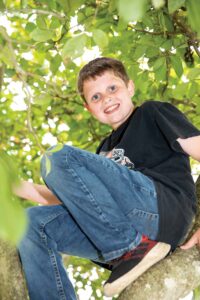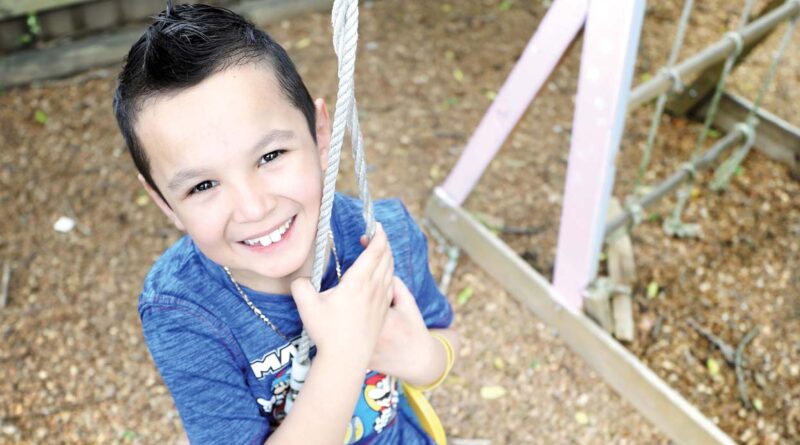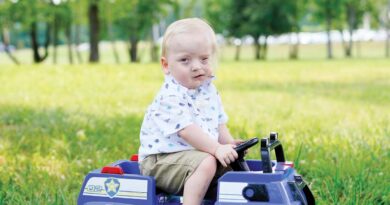Gut Check
Published on September 14th, 2020 by Christina Echegaray.
If you have children, the odds are high they’ve suffered from a temporary gastrointestinal issue — in fact, about 60% of health complaints to pediatricians are for GI symptoms — stomachaches, nausea, vomiting, heartburn, constipation.
But sometimes the issues don’t go away, are more serious than just run-of-the-mill abdominal issues, and more specialized care is required. The D. Brent Polk Division of Gastroenterology, Hepatology and Nutrition at Monroe Carell Jr. Children’s Hospital at Vanderbilt provides comprehensive care for children with nutritional, gastrointestinal or liver disorders including diagnostic evaluations, treatment and disease education.
The division, with 15 specialty programs to support the more complex patient, is nationally among the top 10 busiest programs, ranking 18th in the 2020 U.S. News and World Report rankings.
Between 2015 and 2019, patient visits to the division grew by 50% from 12,930 annual visits to 19,735.
“When gastrointestinal complaints affect patients’ lives and their ability to have a good quality of life, or if it’s a complex case, that’s when they are referred to us,” said Sari Acra, MD, MPH, professor of
Pediatrics and the division’s director. “We are here to heal and support, but also to try to address unanswered questions related to the care of our patients through research and investigation.”
Congenital diarrhea program

At 5 weeks old, Denny Majano wasn’t gaining weight and, in fact, had lost 1 pound since birth. He suffered from severe, chronic diarrhea and tests failed to identify what was wrong.
He was admitted to Monroe Carell Jr. Children’s Hospital at Vanderbilt in 2011 where he would spend almost 2 ½ years in the hospital, many times struggling to survive.
Denny is one of a rare group of infants born with having very loose, large-volume stools that occur multiple times a day. The diarrhea usually starts within the first two to four weeks of life, and if it persists, the infant can become dehydrated and will need to be hospitalized.
His case exemplifies what happens when basic science meets clinical care.
His care team took a step back to explore the bigger picture, bringing together Vanderbilt clinicians and basic research scientists to look at his genetic makeup with whole exome sequencing.
“He was really bad. He wasn’t able to eat; he couldn’t hold anything in his stomach. Everything he ate, he would throw up,” said Denny’s mother, Maribel Giron. “The doctors did one test after another and they came out OK.”
He was ill enough that he wasn’t able to meet his nutritional or fluid needs with eating and drinking by mouth, so for a long period of time he required hydration through an IV, said Denny’s pediatric gastroenterologist Kelly Thomsen, MD, MSCI, assistant professor of Pediatrics in the D. Brent Polk Division of Gastroenterology, Hepatology and Nutrition at Children’s Hospital.
When Sari Acra, MD, MPH, director of the division, conferred with Hernan Correa, MD, chief of Pathology at Children’s Hospital, they noticed subtle changes in the epithelial (tissue) lining of the intestine that suggested abnormalities in epithelial development. They enlisted the help of James Goldenring, MD, PhD, Paul W. Sanger Professor of Experimental Surgery and co-director of the Epithelial Biology Center, an internationally recognized authority on intestinal epithelial biology.
Goldenring determined that some key nutrient transporters weren’t making it to the intestinal cell lining. Recognizing the similarities to another rare form of congenital diarrhea he has characterized, Goldenring felt it was imperative that gene sequencing be performed on Denny. He used his own unrestricted research funds to make that happen.
The three physicians then conceived of a research study supported by the NIH-funded Digestive Disease research Center (DDRC) at Vanderbilt. In collaboration with the HudsonAlpha Institute, they identified a gene mutation in Denny known as DGAT1 (Diacylglycerol O-Acyltransferase 1), an enzyme that catalyzes the formation of triglycerides in the intestine. The team has also helped diagnose genetic mutations in two other children with rare diseases.
The abnormal enzyme function in Denny can lead to profound diarrhea, and the team is now investigating how that causes abnormalities in the delivery of nutrient transporters to the intestinal lining. The team found only two other published cases, and three suspected cases in the world, with Denny’s specific mutation.
Following the discovery of the mutation in May 2015, Denny, then 3 years old, was placed on an extremely low-fat diet. By the next day he was already better. He started gaining weight, and the distended abdomen he lived with for the first years of life, began to disappear. Denny, now 8, was weaned off nutritional assistance within eight weeks of starting the new diet. He is now thriving.
Acra said that most cases of congenital diarrhea are very difficult to diagnose.
“There may be 50 known causes and it’s very difficult for the clinician to figure out which one is the cause of a specific case. Some have treatments. Some don’t. Sometimes it takes years to figure it out through genetic testing that’s not readily available in a clinical lab.
“In Denny’s case, can you imagine the cost of being in the hospital for two and one-half years? But once we figured out the cause, the solution in his case was relatively easy, and he was out of here in eight weeks with no need for nutritional support.”
Children’s Hospital is now a founding partner in an NIH-funded research consortium with three other medical centers — UCLA, Boston Children’s and Toronto Sick Children’s — studying the epithelial biology of congenital diarrhea and other diseases with an epithelial connection. They are collecting tissue from biopsies to help with the research.
“We’re trying to decipher all of these unknown disorders and help in the diagnosis and treatments,” Acra said. “That’s our goal. It’s still a ways off, but it definitely wasn’t going to happen with only one center.”
C. Diff

Clostridioides difficile (also known as C. diff) exists on surfaces all around us. Some people have the bacteria in their intestines and never have any symptoms.
The human body contains thousands of different types of bacteria — some good and some bad. But for more than 200,000 people a year, often after a course of antibiotics that kills off enough healthy bacteria, C. diff doesn’t hide; in fact, after the antibiotics kill off the good bacteria, C. diff flexes its muscle, causing frequent diarrhea with loose watery stools, fever, abdominal tenderness or pain, loss of appetite and nausea. And one in five people will get it again. And again.
The bacteria is often spread in hospitals and nursing homes. You can become infected if you touch clothing, sheets or other surfaces that have come in contact with feces and then touch your mouth or nose. Older adults in health care facilities are most at risk, but the incidence in pediatric patients continues to rise. It’s typically treated with the drug vancomycin, which can be expensive, not always covered by insurance and not always effective for preventing additional C. diff infections.
“The way that I explain it to patients in the clinic is, if you have a garden that’s completely full of shrubbery, there’s no room for weeds to cause trouble,” said Maribeth Nicholson, MD, MPH, assistant professor of Pediatrics in the D. Brent Polk Division of Gastroenterology, Hepatology and Nutrition at Monroe Carell Jr. Children’s Hospital at Vanderbilt. “That’s how most of us exist day to day. But if you start plucking out some of the shrubbery and some of the other plants there, you now have a place where weeds can grow. I think of C. diff as one of those weeds.
“It used to be all patients who had this had an antibiotic history,” Nicholson said. “But now patients are showing up without that, so we don’t know if there was an infection that changed their microbiome or if there are things in the diet that seem to matter.”
Caleb Hartoon, 10, of Ft. Campbell, Kentucky, was 4 when he started having constant diarrhea accompanied by a prolapsing rectum (the bottom part of his large intestine dropped outside his anus).
Caleb spent about 14 days at Vanderbilt on isolation precautions when he was first diagnosed with C. diff. “He was in a lot of pain and his rectum kept prolapsing,” said his mom, Tanya Hartoon. “We stopped counting at 115 prolapses.”
His bouts with C. diff after being released from the hospital continued and after multiple trips to Vanderbilt, in 2014, Tanya and Nicholson decided on a fecal microbiota transplant (FMT), advised for patients with recurrent C. diff infections over the standard treatment — vancomycin.
FMT began about seven years ago at Children’s Hospital. To date, more than 20 of these transplants have been performed.
The concept is simple — you take stool from a healthy donor, give it to the patient sick with C. diff (usually through a colonoscopy), and it repopulates the patient’s microbiome, replacing unhealthy bacteria with a healthy population.
The donors can either be family members who are tested and deemed healthy, or the stool can come from a stool bank where donors undergo extensive screening. In Caleb’s case, his mom was his donor.
“It’s an interesting conversation to have,” Nicholson said. “But I haven’t had a lot of families going through this who aren’t interested in FMT. Most parents have Googled it before they come. They understand the reason and people feel like it feels more natural than additional courses of vancomycin.”
FMT is also costly, because it’s not standardized enough for FDA approval since one stool sample is different from another. “We’d like a manufactured product to work, because it would be a quicker FDA approval, but so far they haven’t performed well enough,” Nicholson said.
Caleb, recovered from his C. diff infection, loves sports and making others laugh. Tanya recalls the 14-day Children’s Hospital stay when a physician was making rounds. Caleb had a self-inflating whoopee cushion that he hid under the blankets before the doctor began rounds. He pressed it several times when the doctor began talking to the medical students accompanying him.
“After a few times, the doc was concerned and asked him if he was OK (seeing as he was admitted for prolapsing from diarrhea). He pulled out the whoopee cushion and showed it to the doc. Everyone got a good laugh at that one,” Tanya said.
Nausea Program

When Caramia Johnson was in the fifth grade, her fear of vomiting became all-consuming. She’d eat her favorite foods, like pizza, and convince herself she needed to throw up. But she wouldn’t. At its worst, her mom, Meredith Freeman, would get calls twice a day from Caramia’s school telling her that her daughter was nauseous and wanted to come home.
“It was completely irrational and controlled her life,” Freeman said. “It interfered with the quality of her life. I tried to make her feel better, but in fact, I was enabling her,” she said.
Caramia suffers from emetophobia, a phobia that causes an overwhelming anxiety about vomiting. It can present as a fear of vomiting in public, a fear of seeing vomit, or a fear of being nauseated. The fear is sometimes triggered by a prior negative experience with vomiting, and despite the nearly constant worry it might happen, most people with emetophobia rarely vomit.
In 2019 when Caramia’s stomach issues began to affect her caloric intake, she was referred to Alexa Russell, MD, and Monroe Carell Jr. Children’s Hospital at Vanderbilt’s nausea program. Food sensitivities and ulcers were ruled out, and she soon began seeing Marcus Wild, a doctoral student in the Department of Psychological Sciences at Vanderbilt University, specializing in clinical psychology. Wild meets with every patient in the clinic, talking to them about the mind/body connection, guided imagery and breathing and relaxation techniques, helping empower them to minimize their symptoms.
“Most times when you have nausea, it’s related to an illness and it goes away,” said Russell, assistant professor of
Pediatrics in the D. Brent Polk Division of Gastroenterology, Hepatology and Nutrition at Children’s Hospital. “In the kids I treat, it doesn’t go away with the resolution of an illness, and it can be hard to treat. You don’t always know the cause and that’s frustrating. I try to focus on the root cause, when we know it, but sometimes that doesn’t really matter. What matters is how we can get them over the symptoms and break the cycle. I have different tools in my bucket that I can offer our patients. Most of the time when they get to me, medications have failed, and they’ve had testing that hasn’t revealed the cause. A lot of our patients are worried that people don’t believe them, because visibly they look fine and the tests that have been run on them are fine. We can customize something out of the box for them.”
Besides those with emetophobia, patients treated in the nausea clinic include those with chemotherapy-related nausea, some with anxiety and stress, those who have nausea related to solid organ transplants, or those who have developed nausea from an eating disorder. “In this clinic, our goal here is to get kids back to where they were before,” said Russell, who completed a fellowship in integrative medicine and who has suffered from nausea due to a chronic illness.
Caramia believes her phobia began when she threw up as a child at school, but her mom believes it was triggered by anxiety when the family moved from Lexington, Kentucky, to Nashville, and continues to be triggered by anxiety about other issues.
“She would practice the breathing exercises Marcus gave her at school when she felt good, so that when she didn’t feel good, the breathing would remind her of those times she felt OK,” Freeman said. Her phobia has gradually improved with treatment, but Russell is recommending desensitization for Caramia, and that’s the next step.
For this technique, the now 14-year-old will be shown photographs of vomit for short periods of time, with the time increasing each time she is asked to look at the photos. “She’ll decide when it’s enough,” her mom said.
EoE program

At Liam Webster’s 2-year-old checkup with his pediatrician in Chattanooga, Tennessee, his mom, Sarah, mentioned that he seemed to have a chronic cough at night and she had noticed that often, after eating a bite of sticky food like rice or bread, he’d cough to clear his throat.
It was one of those things that moms don’t really think are an issue, but a gut instinct says to mention them anyway, just in case.
In Liam’s case, it’s a good thing she did.
After some testing, Liam was diagnosed with Eosinophilic esophagitis (EoE), a chronic, allergy-driven disease which is characterized by eosinophils (allergy cells) that build up in the lining of the esophagus, the tube that carries food from your mouth to your stomach. It’s not life threatening, but if left untreated it can cause permanent damage to the esophagus. About one in 2,000 individuals in the U.S. has it, and the incidence appears to be increasing as food allergies also increase.
Girish Hiremath, MBBS, MPH, assistant professor of Pediatrics in the D. Brent Polk Division of Gastroenterology, Hepatology and Nutrition at Monroe Carell Jr. Children’s Hospital at Vanderbilt, is an expert on esophageal disorders, including EoE. “It can be a pretty nasty disease. We’ve only known about EoE for about 25 years. We’re beginning to understand more about the disease,” Hiremath said, adding that about 200-300 patients with the disease are treated at Children’s Hospital.
After being diagnosed with asthma by his pediatrician, undergoing allergy testing, then receiving the EoE diagnosis from a gastroenterologist, Liam, now 9, was referred to Hiremath when he was 3. At the time, Children’s Hospital was just beginning its EoE clinic.
Children who have EoE exhibit a variety of symptoms, so sometimes it’s hard to diagnose, Hiremath said. Younger children can have non-specific symptoms like vomiting or refusing to drink milk. School-age children often have belly or chest pain. “Teenagers will often come to the emergency room with food stuck in their esophagus,” Hiremath said. “They’ll need an emergency endoscopy to take it out, and if the esophagus closes, we have to go in and put in a balloon to dilate so they can eat again.”
Many patients with EoE also experience gastroesophageal reflux disease (GERD), a chronic digestive disorder that is caused by abnormal flow of gastric acid from the stomach into the esophagus. It’s not uncommon for a patient undergoing treatment for EoE to also be treated for GERD.
“Liam didn’t have any pain or stomach bloating. His was an unusual presentation,” Sarah said.
Hiremath said after a diagnosis, parents are hopeful that just one food can be taken away and their child will be fine, but in most cases it’s a combination of foods causing the EoE and finding out is done by trial and error.
After seeing Hiremath, Liam was put on an elimination diet for soy, dairy and peanuts to rule them out as being possible culprits. Hiremath said that treatments in younger children begin with avoiding the most common foods — dairy, egg, soy and wheat — in a systematic manner.
For Liam, peanuts and soy were added back in and dairy eliminated, but a biopsy through endoscopy still showed 10 eosinophils. EoE patients undergo anywhere between two to four endoscopies a year to keep track of their disease, Hiremath said.
Liam’s family opted to try eliminating dairy and putting him on an aerosol steroid for EoE and Omeprazole, an acid blocker. Liam improved, but not to 100%, so they changed his medication to a “slurry mixture,” a locally acting steroid that Liam took mixed with applesauce two times a day.
The family chose not to put Liam on an extreme elimination diet. “We didn’t want to do that because of our family and our lifestyle. He was already feeling very different from other kids,” she said.
Hiremath said having a child with EoE can be hard on families, too. “Life can be burdensome. They can’t eat certain foods. They have to pack their own meals for school, and parents have to be careful about letting their child attend birthday parties and get-togethers.”
Liam, an active boy who loves to talk and play soccer, is doing very well, Sarah said. They have recently added dairy back into his diet while he continues with medication. “This was his choice,” his mom reports. “He’s loving ice cream and cheese.”
— by Nancy Humphrey
Hope – Summer/Fall 2020




